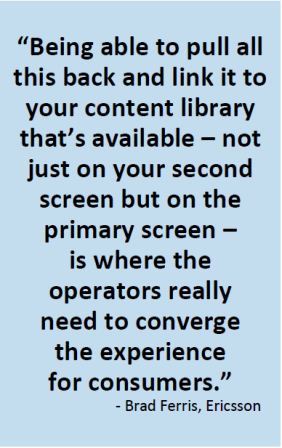
OTTAWA – With more than 40% of consumers watching television with a second screen in their hands, television providers have a tremendous opportunity to enhance the customer viewing experience by better-leveraging the capabilities of the device, argued Brad Ferris, Ericsson TV’s VP of portfolio management.
Ferris, speaking at the Institute of Electrical and Electronics Engineers’ International Conference on Communications in Ottawa on Thursday, criticized the current paradigm deployed by most TV providers. They aren’t taking advantage of the fact that a considerable number of viewers are using a tablet, phone, or laptop while in front of the TV, he said.
According to Ericsson’s most recent Consumer Labs survey of approximately 10,000 TV viewers, 42% of them are either on IM, Facebook, chatting or on Skype on the second screen while the TV provides a background glow. In addition, personalization, usability and the user interface with television programming are becoming increasingly important for consumers.
Ferris acknowledged that consumers can use their mobile device as a remote control or program their DVR recording schedule but there is still a big search problem – of not being able to find anything to watch on TV despite the vast number of channels and the thousands of titles available on video on demand platforms. “From an operator’s perspective, we think there’s a pretty unique opportunity here where they can bring a lot of these aspects together and really leverage that second screen to enhance the overall viewing experience for everything that person is doing while they are in front of the television,” he said.

The advanced capabilities of tablets and smartphones represent a better personal interface to locate content. People could preview it on the personal, smaller device and when they’re ready to watch the program, they can on their large screen TV, Ferris noted. “For search and discovery, we think it’s a better interface and a better experience for the customer to use that second screen,” he argued. Helping users find the content that is relevant to them is very important for the operators and this is turn will help users “feel good about paying their operators on a monthly basis.”
Giving consumers the ability to find content relevant to them can be done through a number of mechanisms. It could be based on what the user is currently watching, what they watched in the past or based on search parameters. “If you’re searching for a Clint Eastwood movie, you might like a movie with Bruce Willis,” Ferris suggested as one example.
“But being able to pull all this back and link it to your content library that’s available – not just on your second screen but on the primary screen – is where the operators really need to converge the experience for consumers such that they can leverage that second screen along with their main television screen,” said Ferris.
There are, of course, enormous challenges. Operators may have to field customer calls regarding their particular devices and how they interact with the cable system and their set top box. In addition, they will have to figure out how to tabulate all the social data – program reviews, comments from viewers and other information – so that viewers will be able to search in an effective way. “Just throwing out recommendations, here’s the top 10 movies watched last week” won’t work, said Ferris.
This new environment has to be converged and not session shifting convergence, where you begin watching on the big TV and then switch to a laptop or a TV in another room.
“This is convergence of your platforms, convergence of your applications on your platforms such that your applications work in conjunction with one another,” said Ferris. “Once we can get to this point of really leveraging the capabilities of that second screen, this will give the consumer more control. It will give them a better user experience and help them be more satisfied with their operator.”



